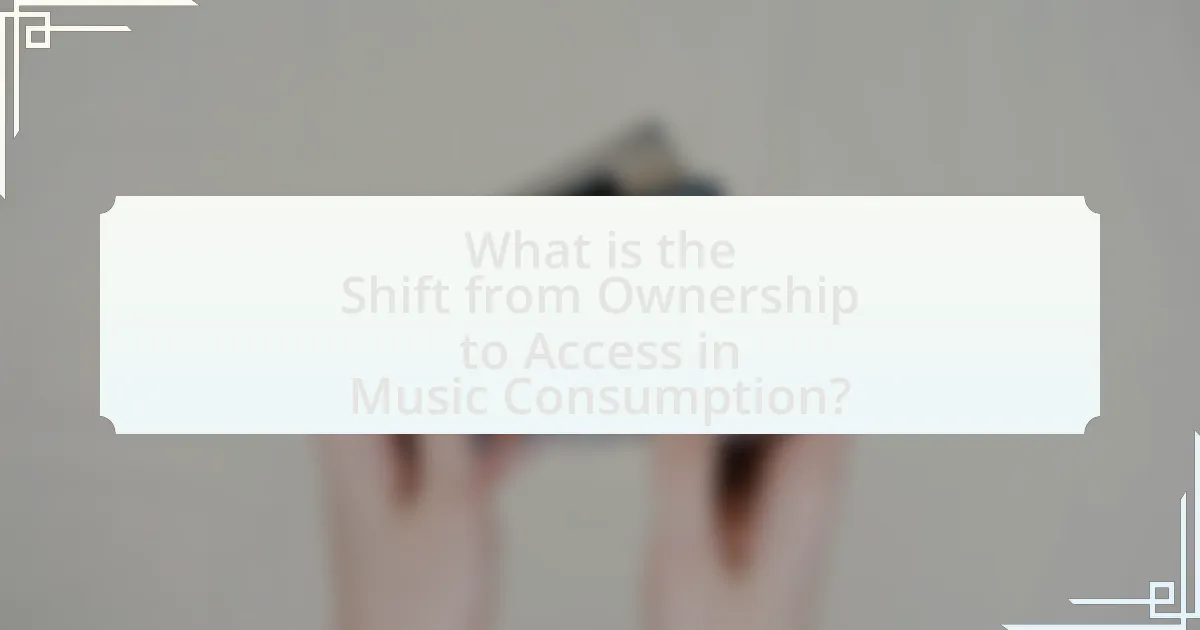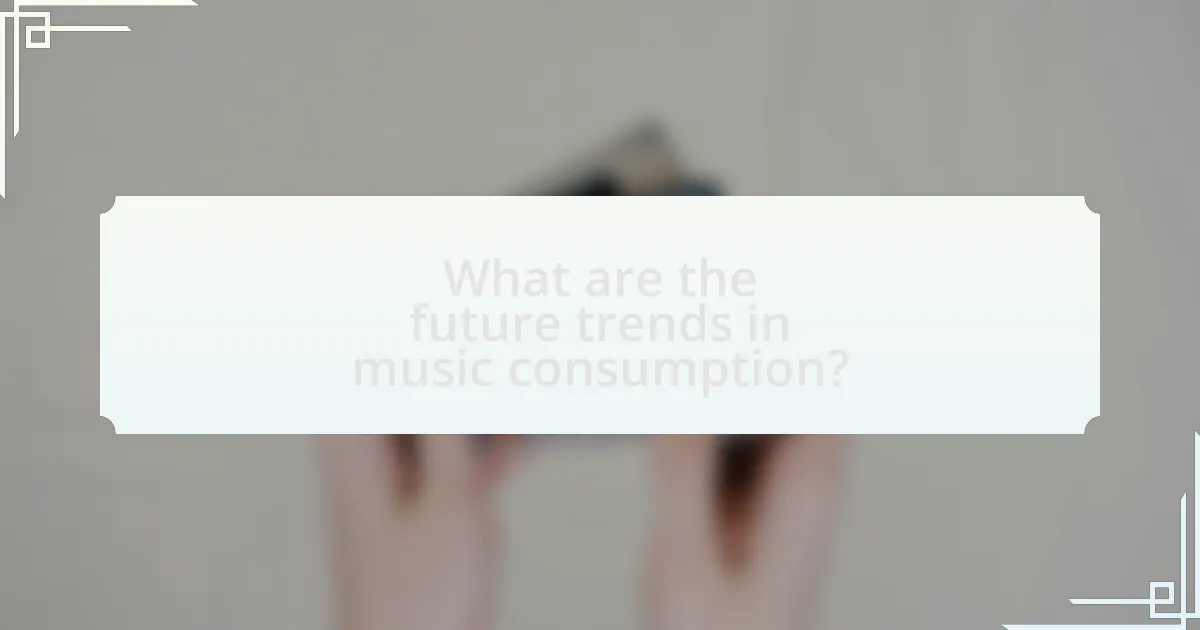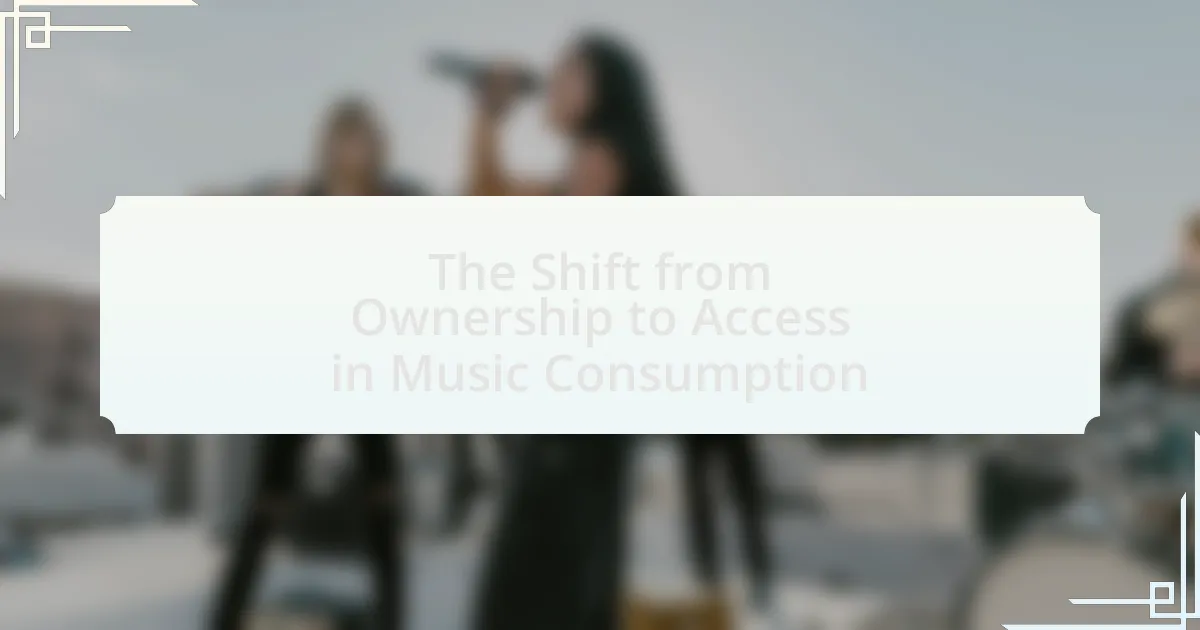The article examines the significant shift in music consumption from ownership to access, highlighting the growing preference for streaming services over traditional purchasing methods. As of 2023, over 80% of music consumption in the U.S. occurs through platforms like Spotify and Apple Music, reflecting a broader cultural trend towards valuing access and experiences. The article explores the historical factors that contributed to this transition, the impact of technological advancements, and the implications for artists and the music industry, including changes in revenue models and audience engagement strategies. Additionally, it discusses emerging technologies and best practices for artists navigating this access-driven market.

What is the Shift from Ownership to Access in Music Consumption?
The shift from ownership to access in music consumption refers to the transition where consumers prefer streaming services over purchasing physical or digital copies of music. This change is driven by the convenience and affordability of subscription models, allowing users to access vast libraries of music without the need for ownership. For instance, as of 2023, over 80% of music consumption in the U.S. is through streaming platforms like Spotify and Apple Music, highlighting a significant decline in physical sales and digital downloads. This trend reflects a broader cultural movement towards valuing access and experiences over ownership in various sectors, including media and technology.
How has music consumption evolved over the years?
Music consumption has evolved from physical ownership of music formats to digital access through streaming services. In the late 20th century, consumers primarily purchased vinyl records, cassette tapes, and CDs, which required ownership of the physical media. The introduction of digital downloads in the early 2000s marked a significant shift, allowing users to buy and own music files. However, the rise of streaming platforms like Spotify and Apple Music in the 2010s transformed music consumption further by emphasizing access over ownership, enabling users to listen to vast libraries of music for a subscription fee or for free with ads. This transition is evidenced by the decline in physical sales and digital downloads, with streaming accounting for over 80% of music industry revenue by 2020, according to the Recording Industry Association of America (RIAA).
What historical factors contributed to the shift in music consumption?
The shift in music consumption from ownership to access has been primarily influenced by technological advancements, changes in consumer behavior, and the rise of digital platforms. The introduction of the compact disc in the 1980s revolutionized music distribution, leading to increased sales and ownership of physical media. However, the advent of the internet in the late 1990s facilitated the rise of file-sharing services like Napster, which disrupted traditional ownership models by allowing users to access vast libraries of music without purchasing individual tracks. This shift was further accelerated by the emergence of streaming services such as Spotify and Apple Music in the 2010s, which offered subscription-based access to extensive music catalogs, fundamentally changing how consumers engage with music. According to a report by the Recording Industry Association of America (RIAA), streaming accounted for over 80% of music industry revenue by 2020, highlighting the significant transition from ownership to access in music consumption.
How did technological advancements influence music ownership?
Technological advancements significantly shifted music ownership from physical formats to digital access. The introduction of the internet and digital formats, such as MP3s, allowed consumers to purchase and download music instantly, reducing the need for physical media like CDs and vinyl records. This transition was further accelerated by the rise of streaming services like Spotify and Apple Music, which offer vast libraries of music for a subscription fee, promoting access over ownership. According to a 2020 report by the Recording Industry Association of America, streaming accounted for 83% of the U.S. music industry’s revenue, illustrating the dominance of access-based consumption over traditional ownership models.
Why is the concept of access becoming more prevalent?
The concept of access is becoming more prevalent due to the increasing demand for convenience and flexibility in music consumption. Consumers prefer streaming services that allow them to access vast libraries of music without the need for ownership, reflecting a broader cultural shift towards valuing experiences over possessions. According to a report by the International Federation of the Phonographic Industry (IFPI), global streaming revenues grew by 19.9% in 2020, highlighting the rising popularity of access-based models in the music industry. This trend indicates that consumers prioritize immediate availability and diverse options, driving the transition from traditional ownership models to access-oriented platforms.
What are the key drivers behind the preference for access over ownership?
The key drivers behind the preference for access over ownership in music consumption include convenience, cost-effectiveness, and the evolving nature of consumer behavior. Convenience is a significant factor, as streaming services allow users to access vast libraries of music instantly without the need for physical storage. Cost-effectiveness plays a role as well; subscription models often provide access to more music for a lower price than purchasing individual albums or tracks. Additionally, consumer behavior has shifted towards valuing experiences over possessions, with many individuals prioritizing the ability to enjoy a wide variety of content over owning specific items. This trend is supported by data indicating that streaming services like Spotify and Apple Music have seen exponential growth, reflecting a clear preference for access among consumers.
How do consumer behaviors reflect this shift?
Consumer behaviors reflect the shift from ownership to access in music consumption through increased subscription service usage and a decline in physical music sales. For instance, as of 2023, streaming platforms like Spotify and Apple Music have reported over 500 million subscribers combined, indicating a preference for access over ownership. This trend is further evidenced by the significant drop in CD sales, which fell by 80% from 2000 to 2022, showcasing a clear consumer pivot towards digital access models.
What implications does this shift have for artists and the music industry?
The shift from ownership to access in music consumption significantly impacts artists and the music industry by altering revenue models and audience engagement. Artists now rely more on streaming platforms for income, which typically offer lower per-stream payouts compared to traditional album sales. For instance, in 2020, the average payout per stream on Spotify was approximately $0.003 to $0.005, leading to a need for artists to generate millions of streams to earn a sustainable income. This shift also encourages artists to focus on building a loyal fanbase through social media and live performances, as direct engagement becomes crucial for monetization. Additionally, the music industry faces challenges in adapting to these changes, including the need for new marketing strategies and the potential for increased competition among artists for listener attention.
How does access-based consumption affect artist revenue?
Access-based consumption negatively affects artist revenue by reducing direct sales and traditional income streams. As consumers shift from owning music to accessing it through streaming services, artists often receive lower per-stream payouts compared to the revenue generated from album sales. For instance, a report by the Recording Industry Association of America (RIAA) indicates that in 2020, streaming accounted for 83% of recorded music revenue, but the average payout per stream is significantly lower than the profit from physical or digital album sales. This transition leads to a reliance on touring and merchandise for income, which may not compensate for the lost revenue from music sales.
What challenges do artists face in an access-driven market?
Artists face significant challenges in an access-driven market, primarily due to reduced revenue streams and increased competition. The shift from ownership to access has led to a reliance on streaming platforms, which often pay artists a fraction of a cent per stream, significantly diminishing their income potential. For instance, a report by the Music Industry Revenue in 2021 indicated that artists earn approximately $0.004 per stream on average, making it difficult for them to sustain a living solely from their music. Additionally, the oversaturation of content on these platforms means that artists must compete for visibility and listener engagement, often requiring substantial marketing efforts and financial investment. This environment can lead to financial instability and creative burnout, as artists struggle to balance artistic expression with commercial viability.

What are the key platforms facilitating this shift?
Key platforms facilitating the shift from ownership to access in music consumption include Spotify, Apple Music, and YouTube Music. These platforms provide subscription-based models that allow users to stream vast libraries of music without the need to purchase individual tracks or albums. For instance, as of 2023, Spotify boasts over 500 million users, with more than 200 million of them being paid subscribers, demonstrating the popularity of access-based consumption. Additionally, Apple Music has over 88 million subscribers, further illustrating the trend towards streaming services as primary sources for music consumption.
How do streaming services redefine music consumption?
Streaming services redefine music consumption by shifting the focus from ownership of music to access through subscription models. This transformation allows users to listen to vast libraries of songs without the need to purchase individual tracks or albums, exemplified by platforms like Spotify and Apple Music, which offer millions of tracks for a monthly fee. According to a report by the Recording Industry Association of America (RIAA), streaming accounted for 83% of the U.S. music industry’s revenue in 2020, highlighting the dominance of access over ownership in contemporary music consumption.
What features of streaming platforms attract users?
Streaming platforms attract users primarily through their vast content libraries, user-friendly interfaces, personalized recommendations, and accessibility across devices. The extensive selection of music, including exclusive releases and diverse genres, ensures that users find content that suits their preferences. User-friendly interfaces enhance the overall experience, making navigation seamless. Personalized recommendations, driven by algorithms analyzing user behavior, increase engagement by suggesting music that aligns with individual tastes. Furthermore, the ability to access content on various devices, such as smartphones, tablets, and smart speakers, allows users to enjoy music anytime and anywhere, contributing to the platforms’ popularity.
How do subscription models impact consumer choices?
Subscription models significantly influence consumer choices by providing access to a vast array of content for a fixed monthly fee, thereby reducing the perceived cost of individual items. This model encourages consumers to explore new music and artists without the financial risk associated with purchasing albums or tracks outright. Research indicates that platforms like Spotify and Apple Music have led to increased music consumption, with Spotify reporting over 365 million users as of 2021, which demonstrates the appeal of access over ownership. Consequently, consumers are more likely to experiment with diverse genres and artists, shaping their preferences and consumption habits in a way that ownership models do not facilitate.
What role do social media and digital marketing play?
Social media and digital marketing play a crucial role in promoting music and engaging audiences in the shift from ownership to access in music consumption. They enable artists and labels to reach vast audiences quickly and cost-effectively, facilitating the discovery and sharing of music through platforms like Instagram, TikTok, and Spotify. For instance, TikTok has become a significant driver of music trends, with songs going viral and leading to increased streaming and sales, demonstrating the power of social media in shaping music consumption patterns. Additionally, digital marketing strategies, such as targeted advertising and influencer partnerships, enhance visibility and foster direct connections between artists and fans, further supporting the transition to access-based models in the music industry.
How do social media platforms influence music discovery?
Social media platforms significantly influence music discovery by facilitating the sharing and promotion of music content among users. These platforms enable artists to reach wider audiences through viral marketing, where a single post can lead to millions of views and shares, as evidenced by the success of songs like “Old Town Road” by Lil Nas X, which gained popularity through TikTok. Additionally, algorithms on platforms like Spotify and YouTube curate personalized playlists and recommendations based on user behavior, enhancing the likelihood of discovering new music. Research indicates that 70% of users discover new music through social media, highlighting its critical role in shaping listening habits and trends in the music industry.
What strategies do artists use to promote their music in an access-based model?
Artists use digital platforms and social media to promote their music in an access-based model. By leveraging streaming services like Spotify and Apple Music, artists can reach a wider audience without the need for physical album sales. Social media platforms such as Instagram, TikTok, and Twitter allow artists to engage directly with fans, share behind-the-scenes content, and create viral marketing campaigns. For instance, TikTok has become a significant tool for music promotion, with songs often gaining popularity through user-generated content and challenges. Additionally, artists frequently collaborate with influencers to amplify their reach, as seen in campaigns where influencers use specific tracks in their videos, driving streams and engagement. This approach aligns with the trend of access over ownership, as consumers increasingly prefer streaming and sharing over purchasing physical copies.

What are the future trends in music consumption?
The future trends in music consumption indicate a continued shift from ownership to access, primarily driven by streaming services. As of 2023, over 80% of music consumption in the U.S. is through streaming platforms, reflecting a significant decline in physical sales and digital downloads. This trend is supported by the increasing popularity of subscription-based models, where users pay for access to vast libraries of music rather than purchasing individual tracks or albums. Additionally, the integration of artificial intelligence in music curation and personalized playlists is expected to enhance user experience, further solidifying the dominance of streaming services.
How might technology further change music access?
Technology will further change music access by enhancing streaming capabilities and integrating artificial intelligence for personalized experiences. Streaming platforms like Spotify and Apple Music already provide vast libraries accessible on-demand, and advancements in AI can analyze user preferences to curate tailored playlists. According to a 2022 report by the International Federation of the Phonographic Industry, streaming accounted for 83% of global recorded music revenue, indicating a significant shift towards access over ownership. As technology evolves, features such as spatial audio and immersive experiences will likely become standard, further enriching how users engage with music.
What emerging technologies could impact music consumption?
Emerging technologies that could impact music consumption include artificial intelligence, blockchain, and augmented reality. Artificial intelligence enhances personalized music recommendations and creates new music through algorithms, significantly altering how listeners discover and engage with music. Blockchain technology offers transparent and secure ways for artists to distribute their music and receive fair compensation, potentially reshaping the music industry’s economic landscape. Augmented reality provides immersive experiences that can transform live performances and music videos, engaging audiences in novel ways. These technologies collectively contribute to the ongoing shift from ownership to access in music consumption, as they facilitate new methods of interaction and monetization in the digital music ecosystem.
How might consumer preferences evolve in the coming years?
Consumer preferences are likely to evolve towards a greater emphasis on access rather than ownership in music consumption. This shift is driven by the increasing popularity of streaming services, which provide users with vast libraries of music for a subscription fee, rather than requiring them to purchase individual tracks or albums. According to a report by the Recording Industry Association of America (RIAA), streaming accounted for 83% of the U.S. music industry’s revenue in 2022, highlighting a significant consumer trend towards access-based models. As technology continues to advance and consumers prioritize convenience and affordability, the preference for access over ownership is expected to solidify in the coming years.
What best practices can artists adopt in an access-driven market?
Artists can adopt several best practices in an access-driven market to enhance their visibility and revenue. First, they should leverage digital platforms for distribution, as streaming services like Spotify and Apple Music dominate music consumption, accounting for over 80% of the market share in the U.S. This allows artists to reach a broader audience without the constraints of traditional distribution methods.
Second, engaging directly with fans through social media and live streaming can foster a loyal community, as artists who interact with their audience often see increased support and sales. Research indicates that artists who maintain an active online presence can boost their fan engagement by up to 50%.
Third, diversifying revenue streams is crucial; artists should explore merchandise sales, crowdfunding, and exclusive content offerings on platforms like Patreon, which can provide financial stability beyond streaming income.
Lastly, collaborating with other artists can expand reach and introduce new audiences, as collaborations often lead to increased streams and visibility. By implementing these practices, artists can effectively navigate the challenges of an access-driven market.
How can artists leverage streaming platforms effectively?
Artists can leverage streaming platforms effectively by utilizing data analytics to understand listener preferences and engagement patterns. By analyzing metrics such as play counts, skip rates, and demographic information, artists can tailor their marketing strategies and music releases to better align with their audience’s tastes. For instance, Spotify provides artists with access to Spotify for Artists, which offers insights into who is listening to their music and how often. This data-driven approach allows artists to make informed decisions about touring, merchandise, and promotional efforts, ultimately enhancing their reach and revenue potential.
What strategies can enhance audience engagement in an access-focused environment?
To enhance audience engagement in an access-focused environment, implementing interactive content and personalized experiences is essential. Interactive content, such as polls, quizzes, and live Q&A sessions, encourages active participation, making audiences feel more involved. Personalized experiences, driven by data analytics, allow for tailored recommendations and communication, fostering a deeper connection with the audience. Research indicates that 80% of consumers are more likely to engage with brands that offer personalized experiences, highlighting the effectiveness of these strategies in increasing engagement levels.

Leave a Reply